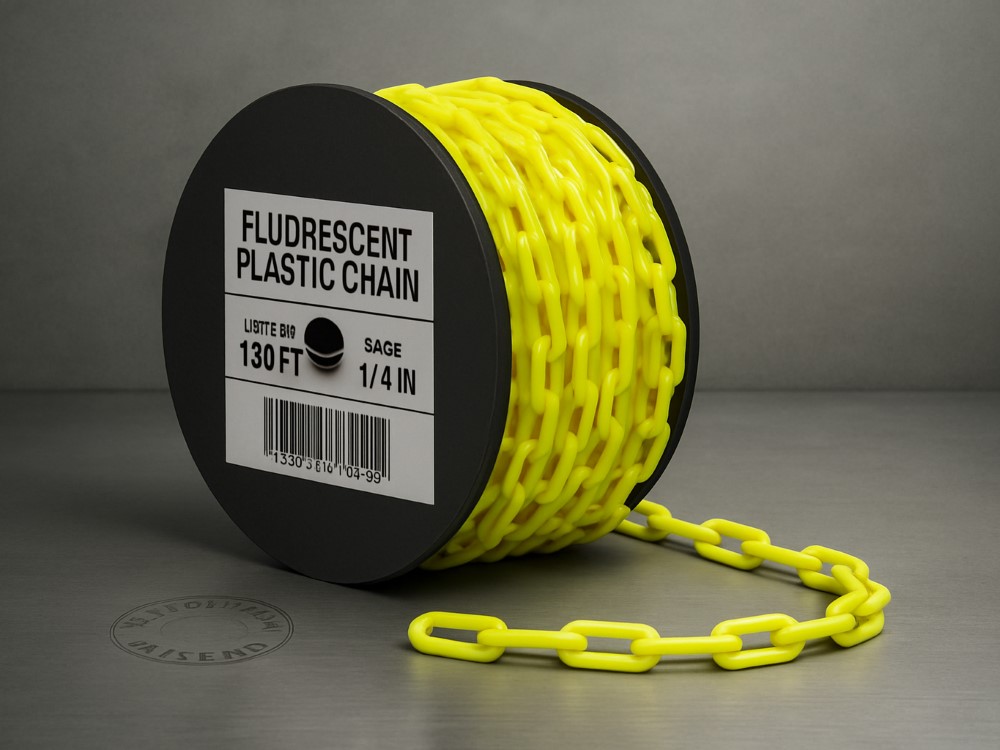Why Plastic Chains Are the Smarter Choice for Safety and Design
Introduction
When it comes to barriers, signage, or decorative elements in public or private spaces, the type of chain you choose matters more than you might think. Traditionally, metal chains have been the go-to solution for strength and reliability. However, plastic chains are rapidly becoming the smarter, more versatile alternative. Whether you’re planning an event, managing a facility, or creating visual markers, plastic chains provide unique advantages in safety, design, and cost-effectiveness. This article explores why plastic chains are outperforming metal ones in various applications.

Key Advantages of Plastic Chains Over Metal Chains
Lightweight and Easy to Handle
Easier Installation and Transport
One of the most significant advantages of plastic chains is how lightweight they are compared to their metal counterparts. A plastic chain link can weigh up to 70% less than an equivalent metal link. This makes transportation easier, installation quicker, and overall handling safer — especially in temporary setups like exhibitions or festivals.
Safety Benefits for DIY and Events
Lightweight doesn’t mean flimsy. Plastic chains are tough enough for marking zones or guiding pedestrian traffic, while being far safer for users to install without special tools. For event staff, volunteers, or retail employees with no technical background, plastic chains eliminate risks associated with metal edges, rust, and pinched fingers.
Durability and Weather Resistance
Rust-Free in Outdoor Environments
Unlike metal chains, which oxidize and rust when exposed to moisture, plastic chains are completely rust-proof. This makes them perfect for outdoor use in parks, parking lots, construction zones, and even marine environments where salt water corrodes metal fast.
UV and Fade Resistance
High-quality plastic chains, especially those made from UV-stabilized polyethylene, retain their color and strength for years. Whether you’re using black, red, or white plastic chain links under direct sunlight, you can expect them to hold up without becoming brittle or fading — something painted metal chains often can’t offer.
Color Versatility for Design and Visibility
Wide Range of Colors
From classic black to high-visibility orange or decorative gold, plastic chains come in a spectrum of colors to match your brand or safety code. This is especially helpful for visual organization — such as designating danger zones (red), safe walkways (white), or premium zones (gold or silver).
High Visibility for Safety Barriers
Bright-colored chains immediately catch the eye, which is essential for effective crowd control, hazard awareness, or pathway guidance. Whether it’s guiding foot traffic at a festival or marking restricted areas on a job site, plastic chains are a reliable and clear visual cue.
Comparing the Applications of Plastic vs. Metal Chains
When to Choose Plastic Chains
Event Management and Temporary Barriers
Plastic chains are a favorite in the event management industry. Their flexibility and ease of use make them ideal for creating temporary pathways, queue lines, or VIP areas. They can be quickly assembled with stanchions or hooks and just as easily taken down after the event.
Indoor and Outdoor Decorative Use
In retail displays, holiday decorations, or theme parks, plastic chains offer an appealing, uniform look that can be customized in color and length. Decorative gold, silver, or pink plastic chains add aesthetic value to spaces where metal chains would look too industrial or cold.
When Metal Chains Still Work Better
Heavy-Duty Load-Bearing Needs
To be fair, metal chains are still the best option for scenarios involving heavy lifting, towing, or load-bearing applications. Their tensile strength is unmatched for hauling or securing vehicles, equipment, or cargo. But for non-load-bearing use cases, plastic chains are usually more practical and cost-efficient.
Cost-Effectiveness and Maintenance
Lower Initial and Long-Term Costs
Plastic chains are not only cheaper to manufacture, but also to ship, install, and replace. You save on labor, transport, and storage — especially for large-scale projects that require hundreds of meters of chain.
Minimal Maintenance
No oiling, repainting, or rust removal is needed with plastic chains. A quick wipe with water or mild soap is often enough to restore them to like-new condition. In contrast, metal chains require regular upkeep to prevent deterioration or aesthetic decline.
Conclusion
Plastic chains have evolved from being seen as a “cheap alternative” to becoming the smart, design-friendly solution in a wide range of industries. With advantages in weight, weather resistance, color options, and cost, they meet modern demands for functionality, safety, and aesthetics. While metal chains still have their place in heavy-duty environments, for most fencing, crowd control, and decorative uses — plastic chains are the superior choice.
👉 Ready to upgrade? Explore our full collection of plastic chain products at Pinkbrand.com!
Frequently Asked Questions (FAQ)
1. Can plastic chains hold weight like metal chains?
Plastic chains are not designed for heavy-duty load-bearing like towing or lifting. However, they are strong enough for light-duty applications such as crowd control, marking areas, or suspending lightweight signs. Always check the manufacturer’s specifications regarding tensile strength and weight limits.
2. What colors are available for plastic chains?
Plastic chains are available in a wide variety of colors including black, white, red, yellow, orange, gold, silver, and pink. These colors serve both aesthetic and functional purposes — for example, red and yellow are often used for safety and visibility, while gold or silver may be used for decorative or branding purposes.
